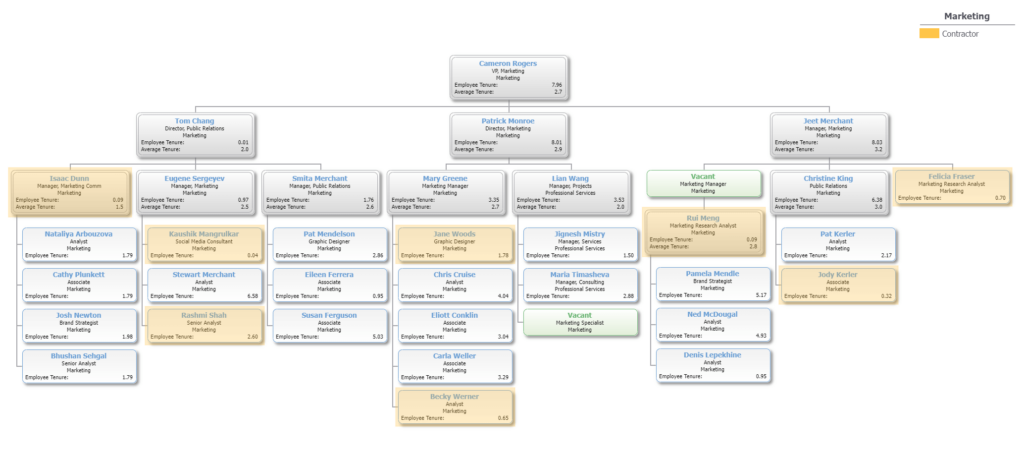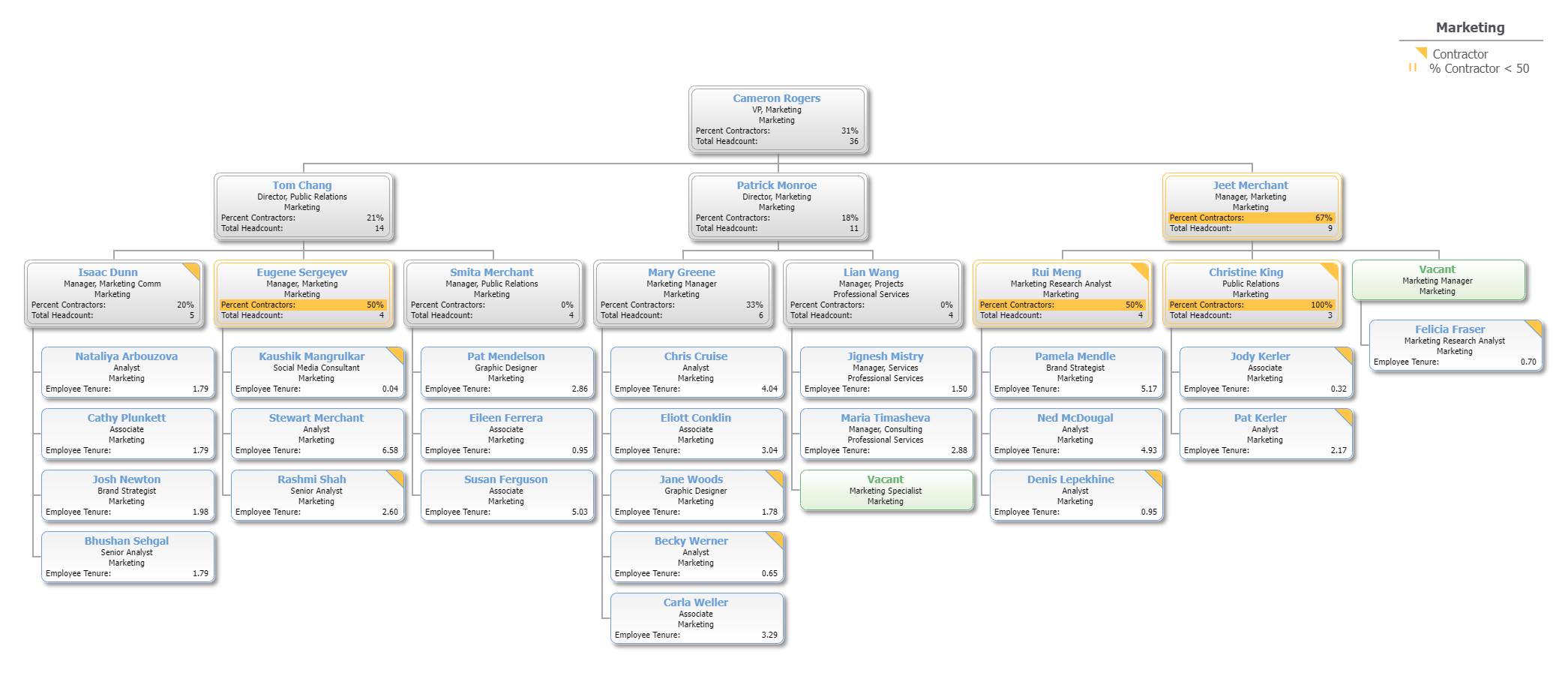February 5, 2020
12:58 PM
By OrgChart Team
Most companies today balance a workforce of employees and contractors. A recent NPR/Marist poll showed that one in five jobs is held under a contract. Loosely defined, an employee often works exclusively for your organization, generally works at your place of business, is entitled to benefits, and has defined working hours. A contractor has the flexibility to work for numerous employers, can work on their schedule, and has specific experience and qualifications in a field that is not covered by many aspects of employment law.
The stakes are high as leaders determine who to employ and who to retain on contract, as healthcare laws and other legal aspects significantly differ. This is a crucial consideration for organizations when managing their workforce composition.
Contractors provide organizations with a way to obtain specialized skills on demand without long-term commitments. This flexibility delivers a strategic advantage, especially in industries where specific skills are only required for a limited duration or for particular projects.

In practical terms, contractors can be beneficial, particularly where there’s a need for a specialized skill set and little/no time to grow it in-house. A CNBC article highlights Silicon Valley’s usage of a “shadow workforce,” of contractors to drive profits and be more agile in the face of change. It’s a viable strategy for some businesses. However, the transient nature of contract work often leads to a lack of commitment to the company’s culture and values, something that organizations need to be mindful of.
While the standard of work is often excellent, “a contractor’s allegiance is typically to themselves rather than the company,” explains Joe Kolinger, a strategic leadership consultant and co-founder of OrgChart, “So as a company works to build a culture of quality, customer care, and alignment with company values, there will be differences between employees and contractors. One has a long-term view; the other has a short-term view. There are exceptions, but generally, an organization overloaded with contractors experiences low allegiance.”
The definition of contractor itself has recently been scrutinized with the emergence of companies such as Uber and Lyft and the “gig economy.” California legislators in 2019 approved a bill that will force these app-based companies to treat their contract workers as employees. The argument is that these companies exert control over contractors’ tasks and that the work is part of their regular business.
It might surprise you that, in a company like Google, which touts its company culture and generous and innovative employee benefits, contract workers now outnumber employees. The Forbes Magazine article “Google Follows a Growing Workplace Trend: Hiring More Contractors than Employees” indicates a shift in the traditional employment model. The advantages of hiring contractors in specific roles might be lower costs to the employer associated with providing benefits and supplies. Disadvantages may include a more transient workforce, with contractors tending to have a shorter tenure than employees who are engaged full‑time.
Given the distinct differences by which employees and contractors must be handled from legal and strategic perspectives, visualizing how they fit into your organization is advantageous. OrgChart lets you highlight contractors and their positions, from key managers to individual contributors, allowing you to see their impact across your organization.

Future planning is a crucial responsibility of HR management. The dynamics of the workforce continuously evolve with changes in employment practices, legislation, and the economic environment.
In this context, the use of organizational charts, or org charts, becomes a powerful tool for strategic workforce planning. An org chart offers a visual representation of the structure of your organization, showing the relationships and ranks of its parts and job positions.
OrgChart software takes this a step further by offering the capability to model “what-if” scenarios. This is particularly valuable in times of change, whether that change is driven by internal factors such as a restructure, or external factors such as new legislation impacting contract workers.
The “what-if” scenarios allow you to experiment with key metrics such as benefit costs, salary, and tenure, and visualize potential changes in your organizational structure. For instance, you could model the impact of hiring more contractors versus permanent staff or explore the effects of changes in employment legislation on your staffing costs.
Moreover, this tool can help measure the financial impacts of freelance workers. By modeling scenarios, HR professionals compare the cost-effectiveness of their employment strategies and make decisions accordingly.
Moreover, the visual nature of an org chart makes it easier to communicate these potential scenarios to others in the organization, aiding in collaboration and decision-making. By offering a clear, visual way to explore potential scenarios, OrgChart helps facilitate strategic discussions and planning in your organization.
With flexible positions, a continually changing variable of today’s HR landscape, keeping a handle on the distribution of these workers is a vital component of organizational management. Scheduling a free demo with OrgChart allows you to explore how this tool can assist in tracking and visualizing your workforce’s composition, providing valuable insights for strategic planning and decision-making.

Schedule a free demo and we can show you how to model “what-if” scenarios to experiment with key metrics such as benefit costs, salary and tenure to measure the financial impacts of freelance workers. With flexible positions a continually changing variable of today’s HR landscape, keeping a handle on the distribution of these workers is a vital component of organizational management.
Google Follows A Growing Workplace Trend: Hiring More Contractors Than Employees, Forbes Magazine, 2019.
Silicon Valley’s dirty secret: Using a shadow workforce of contract employees to drive profits, CNBC, 2018.
Employee or Contractor? Health Care Law Raises Stakes, The New York Times, 2015.
Tags: